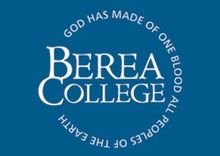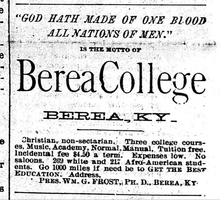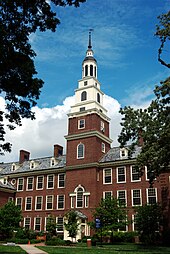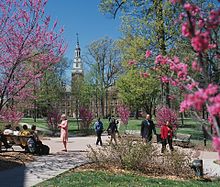Berea College
 Official logo of Berea College | |
| Motto | God has made of one blood all peoples of the earth.[1] |
|---|---|
| Type | Private liberal arts college |
| Established | 1855 |
Religious affiliation | Christian |
Academic affiliations | Space-grant |
| Endowment | $1.25 billion (2020)[2] |
| President | Lyle Roelofs |
Academic staff | 147[3] |
| Undergraduates | 1,688[3] |
| Postgraduates | 0 |
| Location | , Kentucky , United States 37°34′23″N 84°17′31″W / 37.573°N 84.292°WCoordinates: 37°34′23″N 84°17′31″W / 37.573°N 84.292°W |
| Campus | Exurban (140 acres) |
| Colors | Blue and White |
| Nickname | Mountaineers |
Sporting affiliations | NCAA Division III — USA South |
| Website | berea |
Berea College is a private Christian liberal arts work college in Berea, Kentucky. Founded in 1855, Berea College was the first college in the Southern United States to be coeducational and racially integrated.[4] Berea College charges no tuition; every admitted student is provided the equivalent of a four-year scholarship.[4]
Berea offers bachelor's degrees in 32 majors.[4] It has a full-participation work-study program in which students are required to work at least 10 hours per week in campus and service jobs in any of over 130 departments. Berea's primary service region is Southern Appalachia, but students come from 46 states in the United States and 58 other countries, with approximately one in three students an ethnic minority or from outside the U.S.[4]
History[]
Founded in 1855 by the abolitionist John Gregg Fee (1816–1901), Berea College admitted both black and white students in a fully integrated curriculum, making it the first non-segregated, coeducational college in the South and one of a handful of institutions of higher learning to admit both male and female students in the mid-19th century. The college began as a one-room schoolhouse that also served as a church on Sundays on land that was granted to Fee by politician and abolitionist Cassius Marcellus Clay. Fee named the new community after the biblical Berea. Although the school's first articles of incorporation were adopted in 1859, founder John Gregg Fee and the teachers were forced out of the area by pro-slavery supporters in that same year.
Fee spent the Civil War years raising funds for the school, trying to provide for his family in Cincinnati, Ohio, and working at Camp Nelson. He returned afterward to continue his work at Berea. He spent nearly 18 months working mostly at Camp Nelson, where he helped provide facilities for the freedmen and their families, as well as teaching and preaching. He helped get funds for barracks, a hospital, school and church.

In 1866, Berea's first full year after the war, it had 187 students, 96 African American and 91 white. It began with preparatory classes to ready students for advanced study at the college level. In 1869, the first college students were admitted, and the first bachelor's degrees were awarded in 1873. Almost all the private and state colleges in the South were racially segregated. Berea was the main exception until a new state law in 1904 forced its segregation.[5] The college challenged the law in state court and further appealed to the U.S. Supreme Court in Berea College v. Kentucky. When the challenge failed, the college had to become a segregated school, but it set aside funds to help establish the Lincoln Institute near Louisville to educate black students.[6] In 1950, when the law was amended to allow integration of schools at the college level, Berea promptly resumed its integrated policies.
In 1925 famed advertiser Bruce Barton, a future congressman, sent a letter to 24 wealthy men in America to raise funds for the college. Every single letter was returned with a minimum of $1,000 in donation. During World War II, Berea was one of 131 colleges nationally that took part in the V-12 Navy College Training Program which offered students a path to a navy commission.[7]
Up until the 1960s, Berea provided pre-college education in addition to college level curriculum. In 1968, the elementary and secondary schools (Foundation School) were discontinued in favor of focusing on undergraduate college education.[8]
Presidents[]
| Name | Years as president | |
|---|---|---|
| 1 | Edward Henry Fairchild | (1869–89) |
| 2 | William Boyd Stewart | (1890–92) |
| 3 | William Goodell Frost | (1892–1920) |
| 4 | William J. Hutchins | (1920–39) |
| 5 | Francis S. Hutchins | (1939–67) |
| 6 | Willis D. Weatherford | (1967–84) |
| 7 | John B. Stephenson | (1984–94) |
| 8 | Larry Shinn | (1994–2012) |
| 9 | Lyle D. Roelofs | (2012–present) |
(as of 2020)[6]
Academics[]

The college provides significant funding to assist students in studying abroad.[9] Berea students are also eligible to win the Thomas J. Watson Fellowship, which provides funding for a year of study abroad following graduation.[10] Like many private colleges, Berea does not enroll students based upon semester hours. Berea College uses a course credit system, which has the following equivalencies:
- A 0.25 credit course is the equivalent of 1 semester hour.
- A 0.50 credit course is the equivalent of 2 semester hours.
- A 0.75 credit course is equivalent to 3 semester hours.
- A 1.00 credit course is the equivalent to 4 semester hours.[11]
All students are required to attend the college on a full-time basis, which is 3.00 course credits of enrollment, or 12 semester hours. Students must be enrolled in at least 4.00 course credits to be considered for the Dean's list. Enrollment in 4.75 or more course credits requires the approval of the Academic Adviser, and a minimum cumulative GPA of 3.30. There are also optional Summer opportunities to engage in study. Students may take between 1 and 2.25 credits during Summer. One Berea course credit is equivalent to four semester hours (6 quarter hours). Part-time enrollment is not permitted except during Summer term. A cumulative GPA of 2.0 is required in all majors in order to graduate with a bachelor's degree.
Rankings[]
| Academic rankings | |
|---|---|
| National | |
| Forbes[12] | 464 |
| THE/WSJ[13] | 231 |
| Liberal arts colleges | |
| U.S. News & World Report[14] | 33 |
| Washington Monthly[15] | 13 |
In 2021, Washington Monthly ranked Berea College 13th in the U.S. among liberal arts colleges based on its contribution to the public good, as measured by social mobility, research, and promoting public service.[16] The 2021 annual ranking of U.S. News & World Report categorizes Berea as 'more selective' and rates it 33rd overall, 2nd for "Most Innovative Schools", tied for 11th in "Best Undergraduate Teaching" and 9th in "Top Performers in Social Mobility" among liberal arts colleges in the U.S.[17] Kiplinger's Personal Finance places Berea 35th in its 2019 ranking of 149 best value liberal arts colleges in the United States.[18]
Scholarships and work program[]
Berea College provides all students with full-tuition scholarships and many receive support for room and board as well. Berea College charges no tuition; every admitted student is provided the equivalent of a four-year, full-tuition scholarship (currently stated to be worth over $150,000; $39,400 per year for 2018-2019). Admission to the college is granted only to students who need financial assistance (as determined by the FAFSA); in general, applications are accepted only from those whose family income falls within the bottom 40% of U.S. households. About 75% of the college's incoming class is drawn from the Appalachian region of the South and some adjoining areas, and about 8% are international students. Generally, no more than one student is admitted from a given country in a single year (with the exception of countries in distress such as Liberia). This policy ensures that 70 or more nationalities are usually represented in the student body of Berea College. All international students are admitted on full scholarships with the same regard for financial need as U.S. students.[19]
In order to support its extensive scholarship program, Berea College has one of the largest financial reserves of any American college when measured on a per-student basis. The endowment was $1.192 billion as of June 30, 2018.[20] The base of Berea College's finances is dependent on substantial contributions from individuals, foundations, corporations that support the mission of the college and donations from alumni. A solid investment strategy increased the endowment from $150 million in 1985 to its current amount.[21]
As a work college, Berea has a student work program in which all students work 10 or more hours per week on campus. Berea is one of only eight colleges in the United States and one of two in Kentucky (Alice Lloyd College being the other) to have mandatory work study programs. Employment opportunities range from busing tables at the Boone Tavern Hotel, a historic business owned by the college, to editing, writing, publishing, and managing the College's Independent Students' Newspaper The Pinnacle[22][23] or managing the hanging and focusing of lights for the productions at the Theatre Lab. Other job duties include janitorial labor, building management, resident assistance, teaching assistance, food service, gardening and groundskeeping, information technology, woodworking, weaving, and secretarial work. Some of the work-study has helped to extend and support practice of traditional crafts from the Appalachian region, such as weaving. Berea College has helped make the town a center for quality arts and crafts.[24]
Students were, as of 2019, paid an hourly wage from $5.60 to $8.60 by the college, based on the WLS ("Work, Learning, and Service") level attached to individual labor positions.[25] The college regularly increases student pay on a yearly basis, but it has never been equivalent to the federal minimum wage in the school's history. Because of the scheduling demands of both an academic requirement and a labor requirement, students are not allowed to work at off-campus jobs.
Christian identity[]
Berea was founded by Protestant Christians. It maintains a Christian identity separate from any particular denomination. The college's motto, "God has made of one blood all peoples of the earth", is taken from Acts 17:26. One General Studies course is focused on Christian faith, as every student is required to take an Understandings of Christianity course. In an effort to be sensitive to the diverse preferences and experiences of students and faculty, these courses are designed to be taught with respect for the unique spiritual journey of each individual, regardless of religious identification.
Library collections[]
The Hutchins Library maintains an extensive collection of books, archives, and music pertaining to the history and culture of the Southern Appalachian region. The Southern Appalachian Archives contain organizational records, personal papers, oral histories, and photographs. Included are the papers of the Council of the Southern Mountains (1912–1989) and the Appalachian Volunteers (1963–1970).
Student life[]

Since 2002, all students at Berea receive laptops that they take with them when they graduate. Students are not required to pay for the computers, though they do provide a small fee to support the technological infrastructure. Students are also not allowed to have cars on campus without a special permit, and student permits for cars are rarely granted to first- or second-year students. The college provides students with supplemental transport through a shuttle bus system.
Athletics[]
Berea College teams are nicknamed as the Mountaineers. The college is a member of the National Collegiate Athletic Association, competing in Division III. Men's sports include baseball, basketball, cross country, golf, soccer, tennis and track & field; while women's sports include basketball, cross country, soccer, softball, tennis, track & field, and volleyball.[26]
On February 20, 2012, the NCAA announced it had granted Berea permission to begin a one-year period exploring membership in its Division III, non-scholarship athletic program.[27]
On May 4, 2016, the USA South Athletic Conference announced that Berea would join the league effective in the 2017–18 school year.[28]
On February 4th, 1954, Irvine Shanks was in the lineup for Berea against Ohio Wilmington, breaking the color barrier in college basketball in Kentucky.
Notable alumni and faculty[]
- John "Bam" Carney – educator; member of the Kentucky House of Representatives from Campbellsville
- Dean W. Colvard – former president of Mississippi State University, notable for his role in a 1963 controversy surrounding the participation of the university's basketball team in the NCAA Tournament
- William H. Danforth – creator of Purina Dog Chow, author of I Dare You!
- R. Kern Eutsler – bishop in the United Methodist Church.[29]
- John Fenn – recipient of 2002 Nobel Prize in Chemistry.[30] Despite his future success, Fenn always felt that he was handicapped by the lack of meaningful math education in his undergrad years.[31]
- Rodney Griffin – award-winning songwriter and baritone with Southern gospel group Greater Vision
- Finley Hamilton – United States Representative from Kentucky.
- Miss B Hollywood – pop rap recording artist
- bell hooks (Gloria Jean Watkins) – Distinguished Professor in Residence in Appalachian Studies, author of over thirty books
- Julia Britton Hooks – second African-American woman in the United States to graduate from college and paternal grandmother of Benjamin Hooks
- Silas House – NEH Chair in Appalachian Studies, author and activist
- George Samuel Hurst - A health physicist and professor of physics at the University of Kentucky
- Juanita M. Kreps – U.S. Secretary of Commerce under President Jimmy Carter
- Helen Matthews Lewis - sociologist, historian, and activist
- C.E. Morgan – author of All the Living[32]
- Tharon Musser – Tony Award-winning lighting designer known especially for her work on A Chorus Line
- Willie Parker – abortion provider and reproductive rights activist[33]
- K.C. Potter – academic administrator and LGBT rights activist
- Jeffrey Reddick – American screenwriter, best known for creating the Final Destination series[34]
- Jack Roush – founder, CEO, and owner of Roush Fenway Racing, a NASCAR team
- Tijan Sallah - Gambian poet, short story writer, biographer and economist at the World Bank
- Helen Maynor Scheirbeck – Assistant Director for Public Programs at the Smithsonian Institution's National Museum of the American Indian
- James Thindwa – community activist with Chicago's "Jobs with Justice"[35]
- Djuan Trent – Miss Kentucky 2010
- Horace M. Trent - American physicist[36]
- Rocky Tuan – vice-chancellor of the Chinese University of Hong Kong
- C. C. Vaughn - Kentucky educator and minister
- Muse Watson – American actor
- Billy Edd Wheeler – songwriter, performer and writer
- Carter G. Woodson – African-American historian, author, journalist and co-founder of Black History Month
- Chris Thomas Hayes – American film and television actor, writer, and puppeteer. Performs the characters of Hoots the Owl and Elijah, father of Wes, on Sesame Street
See also[]
References[]
- ^ "Berea College: Our Motto". Archived from the original on 2018-07-19. Retrieved 2018-07-19.
- ^ As of June 30, 2020. U.S. and Canadian Institutions Listed by Fiscal Year 2020 Endowment Market Value and Change in Endowment Market Value from FY19 to FY20 (Report). National Association of College and University Business Officers and TIAA. February 19, 2021. Retrieved February 19, 2021.
- ^ Jump up to: a b "College Navigator - Berea College". nces.ed.gov.
- ^ Jump up to: a b c d "Cost of Attendance, 2018-19". Berea College. Archived from the original on 2019-04-10. Retrieved 2019-04-10.
- ^ Richard Allen Heckman and Betty Jean Hall. "Berea College and the Day Law." Register of the Kentucky Historical Society 66.1 (1968): 35-52. in JSTOR Archived 2016-10-07 at the Wayback Machine
- ^ Jump up to: a b "Berea College Early History". Berea College. Retrieved 2020-07-10.
- ^ "Navy V-12 List of Deceased". Berea, Kentucky: Berea College. 2011. Archived from the original on March 31, 2012. Retrieved September 25, 2011.
- ^ "About Berea College - History". Berea College. Archived from the original on 2014-02-17. Retrieved 2014-02-17.
- ^ "Center for International Education: Berea College". Archived from the original on 2009-09-15. Retrieved 2009-10-14.
- ^ "Thomas J. Watson Fellowship: CIE-Berea College". Archived from the original on 2010-06-12. Retrieved 2009-10-14.
- ^ "Academic Services Advisor Guide: Berea College". Archived from the original on 2011-07-19. Retrieved 2009-10-14.
- ^ "America's Top Colleges 2019". Forbes. Retrieved August 15, 2019.
- ^ "Wall Street Journal/Times Higher Education College Rankings 2021". The Wall Street Journal/Times Higher Education. Retrieved October 20, 2020.
- ^ "Best Colleges 2021: National Liberal Arts Colleges". U.S. News & World Report. Retrieved September 24, 2020.
- ^ "2020 Liberal Arts Rankings". Washington Monthly. Retrieved August 31, 2020.
- ^ "2021 Liberal Arts Colleges Ranking". Washington Monthly. 30 August 2021. Retrieved August 30, 2021.
- ^ "Berea College Rankings". U.S. News & World Report. 2020. Archived from the original on December 20, 2018. Retrieved September 16, 2019.
- ^ "Kiplinger's Best College Values". Kiplinger's Personal Finance. July 2019. Archived from the original on 2019-08-21. Retrieved 2019-09-16.
- ^ "Admission Requirements: Prospective Students". Archived from the original on 2009-10-25. Retrieved 2009-10-14.
- ^ As of June 30, 2018. "U.S. and Canadian Institutions Listed by Fiscal Year (FY) 2018 Endowment Market Value and Change in Endowment Market Value from FY 2017 to FY 2018" (PDF). National Association of College and University Business Officers and Commonfund Institute. 2018. Retrieved 2019-07-03.
- ^ Brull, Steven. (September 2005). "Appalachian spring". Institutional Investor, p. 35.
- ^ "The Pinnacle - Guardians of the Students' Right to Know". pub.berea.edu. Archived from the original on 2015-09-08. Retrieved 2015-10-12.
- ^ "About The Pinnacle Newspaper- Berea College".[permanent dead link]
- ^ "About Our Labor Program- Berea College". Archived from the original on 2009-10-05. Retrieved 2009-10-14.
- ^ "Pay Schedule & Scale". Retrieved 2020-07-10.
- ^ "Official Site of the Mountaineers". Berea Athletics. Berea College. Archived from the original on 6 July 2014. Retrieved 22 March 2019.
- ^ "DIII panel suggests consequences for not meeting conference requirements". NCAA.org. Archived from the original on August 31, 2012. Retrieved October 12, 2012.
- ^ "Berea College and Pfeiffer University Set to Join USA South" (Press release). USA South Athletic Conference. May 4, 2016. Archived from the original on May 9, 2016. Retrieved May 6, 2016.
- ^ Hahn, Heather (January 3, 2020). "Bishop Eutsler, Trusted Leader, Dies at 100". United Methodist News. Retrieved 2020-11-10.
- ^ Herschbach, Dudley R.; Kolb, Charles E. (2014). "John Bennett Fenn" (PDF). National Academy of Sciences. Archived (PDF) from the original on 2016-12-20. Retrieved 2016-12-04.
- ^ "John B. Fenn - Autobiography". The Nobel Foundation. Archived from the original on December 21, 2010. Retrieved April 2, 2011.
- ^ The National Book Foundation's "5 Under 35" Fiction Selections for 2009 Archived 2010-07-27 at the Wayback Machine, National Book Foundation, accessed July 27, 2010
- ^ "Willie Parker, M.D. to Speak at Berea College Convocation". Berea College - First Interracial/Coeducational College in the South. 2016-11-07. Archived from the original on 2019-03-28. Retrieved 2019-03-28.
- ^ Biography for Jeffrey Reddick at IMDb
- ^ Moyers, Bill (2009-03-27). Bill Moyers Journal: "James Thindwa" (Television Production). New York, NY: Public Broadcasting Service. Archived from the original on 2009-05-07. Retrieved 2009-07-14.
- ^ "Obituaries, Horace M. Trent". Physics Today. 18 (2): 86. 1965. doi:10.1063/1.3047224.
Bibliography[]
- Adams, John D (2012). "The Berea College Mission to the Mountains: Teacher Training, The Normal Department, and Rural Community Development". Register of the Kentucky Historical Society. 110 (1): 33–66. doi:10.1353/khs.2012.0005. S2CID 154827109.
- Harris, Adam (October 2018). "The Little College Where Tuition Is Free and Every Student Is Given a Job". The Atlantic.
- Peck, Elizabeth. Berea's First Century, 1855–1955. Lexington: University of Kentucky Press, 1955.
- Wilson, Shannon H. Berea College: An Illustrated History. Lexington: University Press of Kentucky, 2006. ISBN 978-0-8131-2379-0
External links[]
| Wikimedia Commons has media related to Berea College. |
- Berea College
- Liberal arts colleges in Kentucky
- Educational institutions established in 1855
- Universities and colleges accredited by the Southern Association of Colleges and Schools
- Buildings and structures in Madison County, Kentucky
- Appalachian culture in Kentucky
- Education in Madison County, Kentucky
- 1855 establishments in Kentucky
- Work colleges
- American Missionary Association
- USCAA member institutions
- Private universities and colleges in Kentucky

